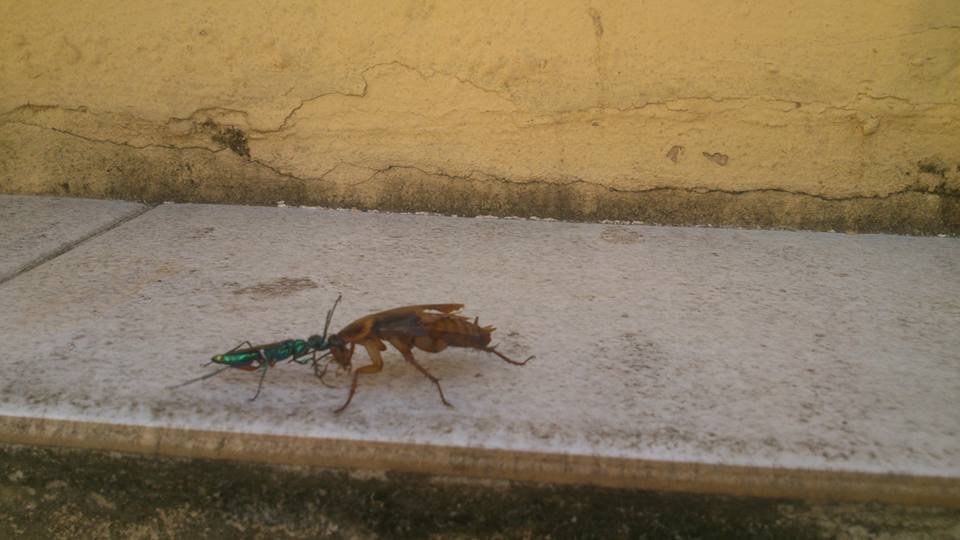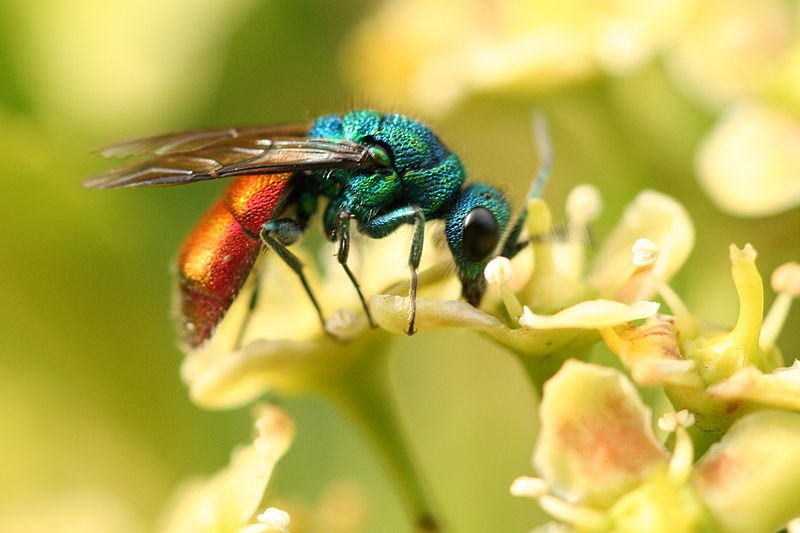Remember the fungi that turns ants into zombie-like slaves that I talked to you guys about a few days ago? Well, if you enjoyed that post you will surely love this one!
Let me introduce you to..
Ampulex compressa, The Wasp That Turns Roaches Into Zombies!

Commonly known as emerald cockroach wasp, this is a solitary species of the family Ampulicidae, mostly found in the tropical regions of South Asia, Africa and the Pacific islands. Also known as jewel wasp, the species is best known for its quite unusual reproductive behavior, which involves having a cockroach injected with mind controlling toxins! But that's just the beginning! Intrigued? Good! Let's take everything from the start!
How and Why Does A. Compressa Turn Roaches Into Slaves?
When the female jewel wasp is ready to lay her eggs, she goes on a journey to find cockroaches. Why? A. Compressa is a parasite and her eggs need to be placed inside a host if they are to hatch. Obviously, no cockroach likes the idea of becoming a host so the emerald wasp has come up with a neat way to do its bidding.
After finding a roach, the wasp will sneak up behind it, mount it and deliver a sting to the prothoracic ganglion of the body. This sting is not meant to kill the roach. The venom just paralyzes the front legsfor the next 2-3 minutes. But that is only the beginning of the torture!
Now that the roach is "sedated" it's time to play doctor and have fun with some quick brain surgery! The wasp places her sting inside the roach’s head, and uses special sensors to feel its way through specific regions of the brain where it releases a cocktail of mind controlling neurotransmitters.
Now that the surgery is over, the wasp will leave the patient to recover and will search for a crevice near the area. While she does that, the cockroach starts to regain function of her body. The roach should run away to live another day but it doesn't! The mind-controlling cocktail has done its magic and the poor roach no longer has any free will... it has entered a "zombie-like" state!
After finding a suitable crevice, the wasp return but playing doctor gets you hungry so she bites off the roach's antennae in half and has a refreshing drink, using what's left of them like a straw. Then she grabs the roach from one of the two antenna stumps and walks her to the crevice. Much like dog on a leash! And unlike some dogs, the roach doesn't pull. The roach is 100 % obedient. Once both are inside the crevice, the jewel wasp lays an egg on the underside of the cockroach. The wasp says her goodbyes and seals the crevice with pebbles, leaving the roach in darkness.
 Jewel wasp walking a cockroach like a dog on a leash!
Jewel wasp walking a cockroach like a dog on a leash!
And now comes the best part. The egg hatches, and out comes a not-so-cute little larva baby. The baby is hungry and needs some motherly warmth so it chews a hole into the roach’s underside, and starts feeding on the insides!
Remember, the cockroach is still alive and well! The larva is no match for her. The roach could crash it with ease. But it doesn't! Instead, the cockroach stays in place, dying slowly as the larva keeps feeding on it. Soon the poor roach is dead and about a week later the larva enters the cocoon stage. Days later, a fully grown wasp pops out the cocoon and digs it way out of the dead roach's body!
The new born wasp exits the crevice and is ready to enslave more cockroaches!
Here's a beautiful video showing and explaining the whole process:
Unzombiefying the zombies
Researchers have found that it is possible to turn cockroaches back into normal with the right antidote. Apparently, the wasp's venom works by blocking a neurotransmitter called octopamine, which is involved in preparations to execute complex behaviours including walking. When the roaches are given a compound that reactivates octopamine receptors, spontaneous walking behaviour is restored.
Some Quick & Interesting Facts
- Studies have shown that during the second sting the wasp actively searches for the sub-esophageal ganglion. In experiments where this part of the brain was removed the wasp keeps trying to find it for up to 3 minutes!
- The strange parasitic relationship between A. Compressa and roaches was first observed back in the 1940s, when researchers noticed that female wasps sting the Australian cockroach (Periplaneta australasiae) twice, once on the thorax and then on the head. But it wasn't until 2003, when a study with radioactive labeling revealed something remarkable. This sting is made with point black precision into specific ganglia of the brain.
- Suitable hosts are Periplaneta americana and Periplaneta australasiae

References & Further Reading
- How to make a zombie cockroach
- Direct Injection of Venom by a Predatory Wasp into Cockroach Brain
- Parasitoid wasp uses a venom cocktail injected into the brain to manipulate the behavior and metabolism of its cockroach prey
- Wikipedia: Emerald cockroach wasp
Photo Credit
All photos taken from wikicommons and released under the creative commons licence
SteemSTEM & Steemiteducation
Please consider supporting the @steemstem project. SteemSTEM is a community driven project which seeks to promote well written & informative Science Technology Engineering and Mathematics postings on Steemit. Click here to join the chat and learn more! The steemstem project is run by @justtryme90, @lemouth and some other cool guys & gals :)
You may also want to check, @steemiteducation, a project for steemian educators and people posting educative content
More Strange Animals To Come
I will be posting one new strange animal each and every day so if you enjoyed this post make sure to follow me and let's discover together some of the world's most strange and bizarre creatures! An upvote and resteem would be nice too :P In the meantime, you may want to check out these 5 Solar-Powered animals, learn how many legs the world's leggiest creature has and discover the world's largest one-cell organism!

